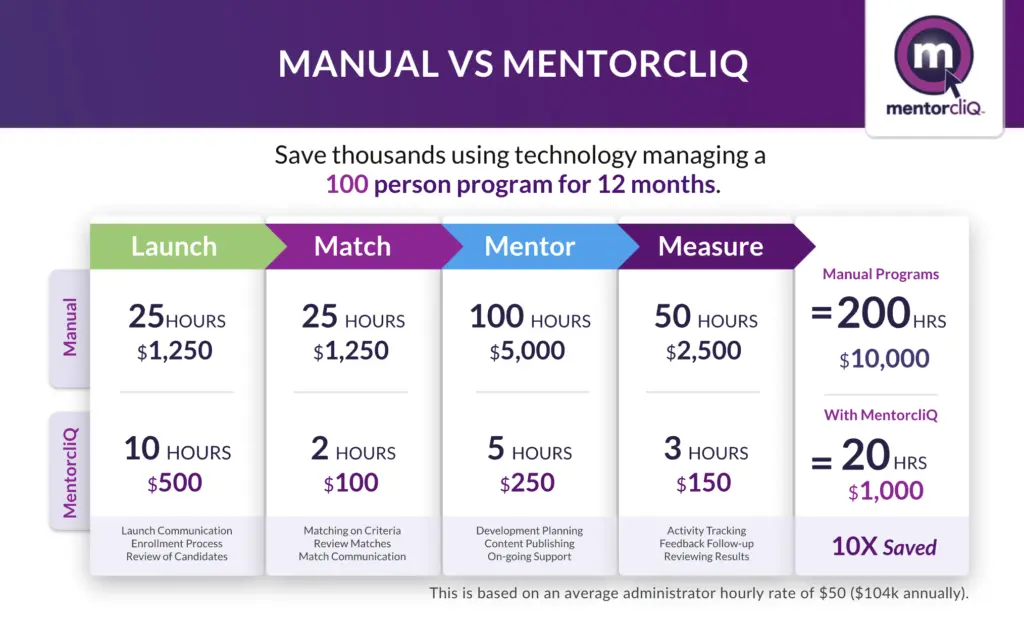One of the biggest hurdles you’ll face when going from planning to execution of a formal mentoring program is in getting the program structure ideated and organized in a way that makes the program easy to launch. A completed mentorship program template is exactly the type of document you need in hand (physically or digitally, your choice) when you’re ready to move beyond the planning phase.
⚡️ Click here to skip right to the mentorship program template generator!
Ready-to-go and fully completed mentorship program templates are useful in numerous situations, especially the following:
- You’re launching a new mentoring program from scratch
- You’re trying to build buy-in from executives for mentoring
- You have a successful mentoring program in place and you’re hoping to launch a new one
Whether your individual situation fits one of the above examples or it’s completely unique, we’ve got you covered. On this page, you’ll find a few of your biggest questions answered about what goes into a mentoring program and why a mentoring program template is a good place to start.
To help you accelerate your way to the launch phase, you can even use our plug-and-play program generator that will help fill out a professional mentoring program template in less than 5 minutes.
How to Structure a Mentorship Program

Mentorship programs are structured learning and engagement tools organizations use to help both new and experienced employees connect and grow in organic and authentic relationships.
Mentoring has proven value, especially considering nearly 98% of Fortune 500 companies have them (and 100% of the top 50). As well, median profits for US Fortune 500 companies with mentoring programs were twice that of those without mentoring.
That’s the why of mentoring, so let’s move on to the how.
- Purpose and type of mentorship program, in alignment with critical business objectives
- Target population (e.g., new hires, women, diverse teams, specific functions, etc.)
- Engagement structure (e.g., 1-to-1, group mentoring, mentoring circles, etc.)
- Matching criteria (e.g., tenure, location, skill levels, etc.)
- KPIs and success indicators
- Anticipated program challenges (or existing challenges with other programs)
- Tools needed to launch effectively
- Launch time frame
Mentoring programs are typically broken down into the following elements that can be included in a template or established within a completed one.
Other elements may be necessary, depending on the unique needs of your organization. However, these 8 focus areas are great for most program managers to consider during the planning stages for mentoring programs. Let’s go over each of these in a bit more detail to help you understand why each of these should be carefully considered when completing a mentorship program template.
1. Mentoring program purpose and type

The purpose of your mentoring program needs to be specific. Those working with you to help launch your program—be it an executive sponsor or the leadership team that will give you and thumbs up or down on approval—need a clearly stated reason for what you hope to achieve with the mentoring program.
For that, we recommend you tie the mentoring program to a distinct and measurable business objective. That may require you to work with others to gather the requisite information or data, but aligning mentoring with business objectives gives the programs more value and potential urgency.
Common business objectives that are well-aligned and solved with mentoring programs include:
- Increasing employee retention
- Upskilling, reskilling, and other learning and development goals
- Building a company culture and improving employee satisfaction and engagement
- Achieving targeted DEI goals
- Growing a leadership pipeline
- Addressing revenue growth through talent development
The type of mentoring program you decide to launch will depend on your stated purpose. While there are no specific restrictions to what you name your mentoring program, most will fall under these broad categories:
- Career Development: Helping mentoring program participants gain move further upward in their careers (ideally within the same organization)
- Functional Development: Helping mentoring program participants learn or refine skills within their function (e.g., sales, marketing, engineering, etc.)
- Community Building: Programs designed to improve the company culture. These are particularly important in remote work environments
- Enterprise Open Mentoring: Programs that allow individuals within the organization to find and connect with others on an ad hoc basis for their own purposes or for just-in-time mentoring needs
Unsuccessful mentoring programs often try to offer too much at once. Getting executive buy-in might require you to narrow your focus and work out how to align the program’s objectives with that of the overall business.
You’ll find some sub-categories in the mentorship program template generator included at the bottom of this page.
⚡️ Click here to skip right there if you’re ready to start crafting your mentoring program!
2. Target population
Your target population will consist of potential mentees who will fill the ranks of your mentoring program. It’s good to have a “why” attached to this population, although that will likely align with the purpose of the program.
That said, mentoring programs tend to benefit for the mentors and the mentees. We’ve found that job satisfaction increases and turnover rates decrease for mentees just as much as it does for mentors. And if you’re running a reverse mentoring program, the senior-level team members who would typically serve as mentors in more traditional programs are the target population.
3. Engagement structure
Your mentorship program’s engagement structure will likely be one of the following:
- 1-to-1
- Group mentoring
- Mentoring circle
- Reverse
We have clients who have fairly unique program structures that don’t fit easily into one of those categories. Nevertheless, there’s a good chance that the engagement structure of your mentoring program will fit right into one of those.
If your idea for a mentoring program doesn’t really align well with one of those, and you’re unsure of exactly how to structure it, book a call with us today and let us help you navigate your program structure.
4. Matching criteria
How you match mentors and mentees will be the single biggest determinant of whether those relationships go on to be successful. You need to put in the work to ensure these matches are right first time.
Poorly matched mentors and mentees don’t connect well on the social, emotional, and human levels that lead to program success. It’s quite simple:
Bad matches = bad results.
Your exact matching criteria are really dependent on the outcomes you hope to achieve with your program.
For example, if you’re running an onboarding mentoring program, and you want new hires to feel more connected to their onboarding mentor but not intimidated by them, you may set a limit to how far apart they’ll be in their tenures, such as a maximum of 3 years difference in tenure or rank.

Is there a science to matching? Absolutely! Alongside making sure you choose the right matching option for your program, MentorcliQ mentoring software is designed with an algorithmic approach to matching that receives the criteria inputs you decide, and creates matches that are scientifically proven to lead to better outcomes.
Mentoring software cuts the amount of time required to create pairs based on a larger set of criteria, making it easier to scale programs at a significantly reduced cost, removing the bias that can run with manual matching and creating long-lasting successful partnerships.
5. KPIs and success indicators
Plan with the end in mind. That includes the type of data you’re going to need to collect from your mentoring program. Delivering solid mentoring ROI will prove that your executive team wasn’t in the wrong in putting their trust and a budget behind your program.
This will ultimately also align with the business objectives that the program is intended to meet or the problems it’s designed to solve. Commonly, however, the type of data you may want to gain are both qualitative and quantitative.

Quantitative data you can gather from the program include participant retention rates (compared to non-participants, especially), and participant promotion rates.
Qualitative data you can gather from the program include job satisfaction rates and mentoring program satisfaction rates.
This is also where a mentoring platform comes in handy. Data gathering is hard, especially if your program is large. Automate the process as much as possible to not only save yourself time but to guarantee your data is accurate and provable.
6. The anticipated program challenges
What are the biggest challenges facing your existing programs, or that your proposed program will face? Executive teams will want you to be able to not only identify the hurdles you’ll face as you attempt to launch but also see that you’ve thought of solutions to those challenges.
Everything from matching participants to effective program promotion and building buy-in from mentors and mentees to sussing out and evaluating the data are common problems for program administrators. Identify the problems you’re going to face, then speak to how you plan to address those problems as you launch and manage your program.
7. Tools needed to launch and manage effectively
Getting your program off the ground is going to require different tools. Traditionally, mentoring programs have relied on program administrators sifting through profiles (by hand), trying to determine mentor-mentee matches (again, by hand), and then putting all of this information into Excel spreadsheets.
Depending on the size of your program, you may not need many tools. But if any of the following are true, mentoring software is likely going to be a boon for you:
- You plan to have multiple programs
- You plan to start with a small pilot (under 100 people) and then scale at full launch
- You plan to manage one or more programs with a small number of program administrators
- You have limited time flexibility to create, launch, and manage programs due to
As noted earlier, mentoring software is necessary for effective matching, data collection, and analysis. It’s also going to be needed if you want to increase the size of your program, run multiple programs, or have limited time as an administrator to do everything using a traditional approach that lacks automation and customization.
8. Launch time frame
Finally, when do you hope to have your program up and running? A program that is fully launched is one that has been:
- Built within a platform
- Integrated with an HRIS
- Secured from a data privacy perspective
- Rosters filled with mentors and mentees
- Mentors and mentees are paired and ready to start meeting
Depending on the size and complexity of your program, launching could take a few weeks or several months. Be honest and realistic about your launch time frame. It’s better to give a longer window and launch faster than expected than to assume your launch time frame will be much shorter and then have to push the launch date back again and again.
Time to Build an Effective Mentorship Program
Now that you understand all of the elements that go into planning for your mentorship program, it’s time to take the next step. Use the following mentorship program template generator to create and send yourself a ready-to-go mentoring program document.
You can use this to document to gain buy-in from executive sponsors, to get the coveted buy-in and a budget from your executive teams, or to plan out your next stage of program development if you’ve already received executive approval. No matter the size or scale of your scheme, MentorcliQ can help you formalize your plans and support the personal and professional growth of your team.




